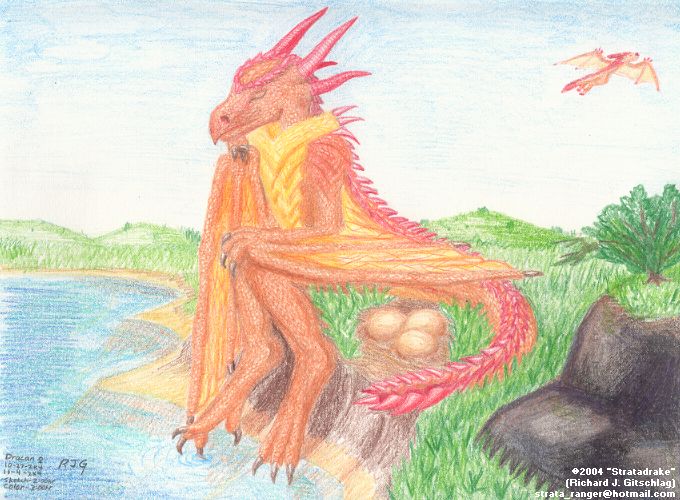A Family is Born
A Family is Born
A Family is Born by Stratadrake

Description
Description
It has been about three years since I last drew one of my dracans, and interestingly, their physiology hasn't evolved or changed very much since that time.
Okay, meet a dracan -- or dracenne if you will, because this one's a female. Dracans are my race of "dragon-people". If you created a physiological spectrum with human on one end and dragon on the other, the dracans would weigh in at approximately 75% dragon, 25% human. That's not to say they are hybrids, though -- genetically speaking they are not dragons, and they obviously are not humans either. What they are is a separate race evoking the qualities of both -- the fierce, dragonlike appearance, and a civilized, almost humanlike nature and society.
The female in this picture has just given birth to three young. Dracans are an egg-laying race, and as you might expect, no event is more sacrosanct than the birth of their young, which occurs an average of three seasons after mating. The young develop inside the female for most of that time, creating in a noticeable increase in her girth, and the extra weight makes it difficult for her to fly -- sometimes the female remains on the ground and avoids flying entirely. Near the end of her term, the female lays her offspring as eggs, typically two or three, but sometimes one, or as high as four. Unlike with humans, the young born in a single clutch are not called 'twins' or the like. To an egg-layer, 'twins' happen only if more than one child is born from a single egg.
Anyway; once her eggs are laid, the female's sacred duty is to protect them until they hatch, which is typically about one day later; and the male's duty is to find food for her and the new offspring.
Dracans prefer to live in large numbers among their own kind, which eases the task of raising their young, but they have been known to give birth while in the wild, away from home. Pictured here is such an example.
The pose of this dracenne is based on Rodin's Le Penseur, although the similarities between this and Penseur pretty much stop there.
Medium: Colored & ebony pencil, plus minor editing
Time: About 4~5 hours
Scale (full view): 60px/in
Other notables:
- Designed for, and a 1st-place winner of, lil_taifan_123's "Original Character In Famous Pose" contest, plus special mention for most original picture:
http://www.fanart-central.net/forums/index.php?showtopic=4813&st=75#entry219268
- A 'Best In Show' winner of DragonicFlames's "Dragons & Characters" contest:
http://www.fanart-central.net/forums/index.php?showtopic=5820
Interested in joining an FAC contest? Then go check out our Contests forum at:
http://www.fanart-central.net/forums/index.php?showforum=6
Okay, meet a dracan -- or dracenne if you will, because this one's a female. Dracans are my race of "dragon-people". If you created a physiological spectrum with human on one end and dragon on the other, the dracans would weigh in at approximately 75% dragon, 25% human. That's not to say they are hybrids, though -- genetically speaking they are not dragons, and they obviously are not humans either. What they are is a separate race evoking the qualities of both -- the fierce, dragonlike appearance, and a civilized, almost humanlike nature and society.
The female in this picture has just given birth to three young. Dracans are an egg-laying race, and as you might expect, no event is more sacrosanct than the birth of their young, which occurs an average of three seasons after mating. The young develop inside the female for most of that time, creating in a noticeable increase in her girth, and the extra weight makes it difficult for her to fly -- sometimes the female remains on the ground and avoids flying entirely. Near the end of her term, the female lays her offspring as eggs, typically two or three, but sometimes one, or as high as four. Unlike with humans, the young born in a single clutch are not called 'twins' or the like. To an egg-layer, 'twins' happen only if more than one child is born from a single egg.
Anyway; once her eggs are laid, the female's sacred duty is to protect them until they hatch, which is typically about one day later; and the male's duty is to find food for her and the new offspring.
Dracans prefer to live in large numbers among their own kind, which eases the task of raising their young, but they have been known to give birth while in the wild, away from home. Pictured here is such an example.
The pose of this dracenne is based on Rodin's Le Penseur, although the similarities between this and Penseur pretty much stop there.
Medium: Colored & ebony pencil, plus minor editing
Time: About 4~5 hours
Scale (full view): 60px/in
Other notables:
- Designed for, and a 1st-place winner of, lil_taifan_123's "Original Character In Famous Pose" contest, plus special mention for most original picture:
http://www.fanart-central.net/forums/index.php?showtopic=4813&st=75#entry219268
- A 'Best In Show' winner of DragonicFlames's "Dragons & Characters" contest:
http://www.fanart-central.net/forums/index.php?showtopic=5820
Interested in joining an FAC contest? Then go check out our Contests forum at:
http://www.fanart-central.net/forums/index.php?showforum=6
General Info
General Info
Ratings
Category Fantasy » Dragons » Anthro/Human Dragons
Date Submitted
Views 2966
Favorites... 3
Vote Score 0
Category Fantasy » Dragons » Anthro/Human Dragons
Date Submitted
Views 2966
Favorites... 3
Vote Score 0
Comments
4
Media Unspecified
Time Taken
Reference
Media Unspecified
Time Taken
Reference
Comments
You are not authorized to comment here. Your must be registered and logged in to comment
Moonlightelf on February 2, 2006, 2:37:35 AM
Moonlightelf on
